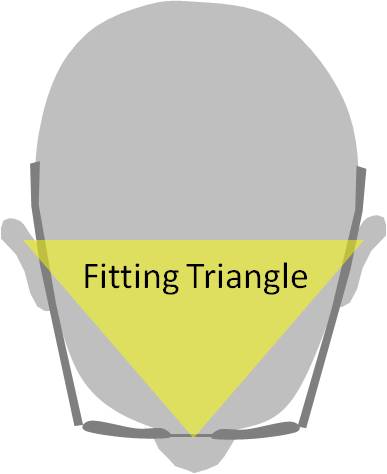Articles | Eyewear Frame Mechanics

Illustration of the fitting triangle.
Adjustment of the eyewear frame on the user is often based on the fitting triangle. These three contact points, namely, the nose bridge and the crest of both ears support the eyewear on the face.
Facing forward, the main force that keeps the eyewear in place is friction from the nosepad on the nose. When the friction from the nosepad is adequate, friction from the temple is not required. Otherwise friction from the temple has to play a bigger role to stop the eyewear from slipping. The weight and friction of the temple resting on the ears also prevents the frame from tipping forward.
When facing down, the weight of the frame and the lens pulls the eyewear away from the face. The main force (friction) that stops the eyewear from slipping now comes from the temple instead with minimal support from the nosepad. Force from the eyewear temple that keeps it from slipping acts from two direction, first is from the weight of the temple resting on the crest of the ear and second is from the temple gripping the side of the head. Whether the temple is stiff or springy, the force acting on the side of the head needs to be adequate such that it is sufficient to hold the eyewear but not exerting too much pressure so as to cause headache or soreness.
For the layman, pressure and force may seem the same but they are not exactly the same. Pressure is the force exerted over the contact area. Given the same force, pressure increases when the contact area reduces. High pressure is the cause of headaches and soreness. Certainly, increasing the force while maintaining the same contact area will also increase the pressure. However, higher force will also help in reducing eyewear slippage. Figure 1 below shows how force and pressure influence eyewear slippage and user comfort.
 Figure 1. Influence of force and pressure exerted from the eyewear temple against user head on eyewear slippage and user comfort |
From Figure 1, it can be seen that the eyewear frame on the bottom right quadrant is the most desirable as it is comfortable and non-slipping. The worst is the top left quadrant where the eyewear hurts and it still slips. Most eyewear frames fits in the bottom left quadrant where it is comfortable but suffers from slipping. This is especially so in cases where the lens are heavier. In this case, accessories may be used to increase the friction of the eyewear system.
Read also
14 July 2018
26 July 2018
27 January 2018